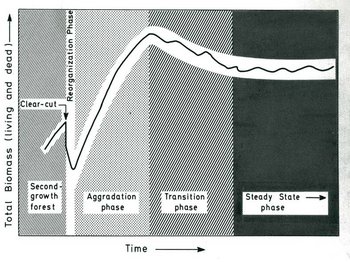Shifting mosaic steady-state
Contents
The Concept
Developed by Bormann and Likens in the late 1970’s, the Shifting Mosaic Steady-State (SMSS) is a concept that describes a forested landscape where patches of that landscape are at different ecosystem development phases, but the landscape’s total biomass remains fairly constant through time. Thus the steady-state exists at the landscape scale but not at the patch scale. It suggests that the maximum total biomass of the landscape is not at this later, steady-state, “old growth” stage, but rather when the biomass for each individual forest patch is at a synchronous maximum, prior to its “old growth” stage (See Figure 1).
Bormann and Likens suggest that steady-state in a forest ecosystem is achieved when the total biomass of the landscape begins to oscillate around a mean. The proportion of an ecosystem in each phase of development remains relatively constant through time, while any single patch of that ecosystem may gain or lose biomass. The total biomass begins to oscillate around a mean in the steady-state phase, assuming no other large-scale exogenous disturbance (such as fire or hurricane) occurs.
Origin
F. Herbert Bormann and Gene Likens developed the SMSS concept in 1979. From a study of many small forest plots at the Hubbard Brook Experimental Forest in New Hampshire, they noticed at any point in time, each plot was at a different stage of recovery from disturbance. Despite their observation that a forest patch was always changing as a result of the dynamic between growth and mortality, Bormann and Likens concluded that the final stage of ecosystem development at the larger scale was a shifting mosaic of development phases, where total biomass reached an approximate steady-state.
Using JABOWA, a computer model developed for estimating long-term living biomass trends in northern hardwood forests, Bormann and Likens predicted living biomass in tons/ha for a variety of ecosystem parameters post disturbance. For example, using JABOWA they estimated that a northern hardwood ecosystem on deep till at an elevation of 600 m, and under typical growing conditions, would reach a peak living biomass of 410 tons/ha at 170 years after clear-cutting. Bormann and Likens developed their ideas about the trends of living biomass accumulation through time by studying the long-term growth simulations produced by this computer model.
Challenges for Implementation
In Pattern and Process in a Forested Ecosystem, Bormann and Likens suggest that SMSS can help practitioners develop sustainable, long-term management plans. However, the main challenge of SMSS is determining the scale at which the concept is applicable. How large must a landscape be before a measurable steady-state emerges? For example, the experimental watersheds from which this concept developed, ranged from 10 to 50 ha. This scale may not be applicable to the management of thousands of hectares.
Further Reading
Bormann, F.H., Likens, G.E. Pattern and Process in a Forested Ecosystem. New York: Springer-Verlag. 1979.
Author notes
This article created as part of the Student Science Communication Project. Graduate student authors: Autumn Foushee and Jennifer Wright, Reviewer: Dr. Jeffrey Hughes. Class: Conservation Techniques and Approaches. See: EoE in the Classroom
